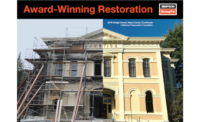Preservation Helps Uplift and Heal: A Considered Approach for California Communities

Photo courtesy of Page & Turnbull
Various initiatives around the country are showing how the built history of a community can play a role in helping uplift the stories of African American and Black people today.
New and unique collaborations of social justice leaders, city planners and cultural resources specialists in California, for example, offer a promising response — and a model for other cities. Uncovering Black history and influence on the built environment that has been overlooked and even intentionally hidden for decades is a tangible step that cities can take in advancing equity and justice, according to Page & Turnbull, a firm involved in several such initiatives.
The Sacramento African American Experience History Project is documenting and recognizing the contributions of the African American community to the City of Sacramento, California, with input from local community members. The city’s Office of Diversity and Equity and Planning Division earned a grant from the National Trust for Historic Preservation’s African American Cultural Heritage Action Fund “to preserve and protect places that have been overlooked in American history and represent centuries of African American activism, achievement and resilience.” The goal is to achieve “equity-driven outcomes that benefit all Americans.”
A second example has been a partnership — between social justice collective Healing Justice Santa Barbara; the City of Santa Barbara, California’s Community Development Department; and the preservation and cultural resources expert Page & Turnbull — to offer a new tool in the national reckoning with legacies of destabilizing racism and the fight for more equitable communities.
“Equitable historic preservation is a tool for social justice,” said Simone Ruskamp, co-founder of Healing Justice Santa Barbara.
Both of these initiatives involve a historic context statement, which examines the history of African American and Black communities through the built environment. “The HCS helps to identify buildings and sites important to the community and sets a framework to recognize and designate these places as landmarks,” said Flora Chou, an associate principal and cultural resource specialist at Page & Turnbull.

Photo courtesy of Page & Turnbull
Illuminating Rich Histories
While cities like Sacramento and Santa Barbara are typically associated with a history of indigenous and Spanish mission settlements, the migration and activities of African American and Black communities are less recognized. The deep, rich histories of Black communities have always been there, and they influenced business and commercial development, religion and spirituality, civic engagement, and arts and recreation, among other aspects of culture today. These studies shed light on those influences, bringing to the forefront people and their contributions through decades and centuries.
Information on the Sacramento African American Experience Project, which held a number of public presentations earlier this year, may be found here.

Photo courtesy of Page & Turnbull
It calls for detailed historical research, collecting oral history and historical documents and producing a “thematic historic context that documents the historical African American experience in Sacramento,” according to the city, which will maintain the recorded oral histories at the Center for Sacramento History. “Community involvement in the project is essential for ensuring accurate and complete documentation of Sacramento’s African American history.”
The Santa Barbara project — honored by the California Preservation Foundation, the state’s American Planning Association and the Santa Barbara Trust for Historic Preservation — has been held up as a model for other communities. Details about that historic context statement and other findings, which were presented publicly last year, may be found here.
Looking for a reprint of this article?
From high-res PDFs to custom plaques, order your copy today!









